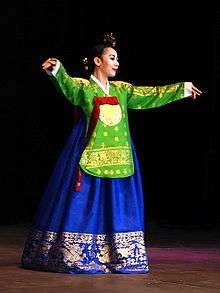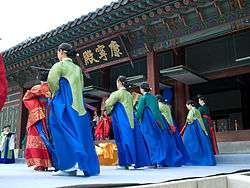Dangui
Dang'ui (Korean pronunciation: [tɐŋɰi]) is a type of upper garment for women in hanbok, Korean traditional clothing, which was worn for ceremonial occasions during the Joseon Dynasty. It was worn as a simple official outfit or for small national ceremonies while court ladies wore it as a daily garment.[1] Dangui was also called dang-jeogori (당저고리), dang-jeoksam (당적삼), or dang-hansam (당한삼).[2]
| Dangui | |
 | |
| Korean name | |
|---|---|
| Hangul | 당의 |
| Hanja | |
| Revised Romanization | dangui |
| McCune–Reischauer | tangŭi |
Origin
It is theorised dangui dates back to the Korean Three Kingdoms period (57 BC - 668 AD) when a clothing system of China was introduced to Korea. The letter, dang (唐) refers to Chinese Tang Dynasty (618 – 907), so dangui may have been adapted from its clothing along with other ceremonial robes such as hwarot and wonsam. Whether the theory is probable or not, it is certain that dangui was worn during the Joseon period, based on historical documents and remains. The scholar, Yi Jae (李縡 1680 ∼ 1746) mentioned dangui in his book, Sarye pyeollam (literally "Easy Manual of the Four Rites"[3]) which defines four important rites based on Confucianism.[4][5] In the chapter, Gwallyejo (冠禮條) on coming-of-age ceremonies, samja (衫子) is commonly called dangui and its length reaches to the knees and its sleeves are narrow. It is also a woman's sangbok (常服), daily garments when working.[2][6][7] [8]
Features
The queen consort, the king’s concubines, sanggung (court matron), and yangban women (nobility) wore the garment over a short jacket called jeogori. According to color, there were yellowish green, purple, navy, and white-colored dangui and others, but yellowish green colored one was the most commonly worn dangui during the time.[2]
In addition, dangui can be divided into two types depending on its layer; a double layered dangui (gyeop-dangui 겹당의), and a single layered one (hot-dangui, 홑당의). The former was usually worn during winter while the single layered dangui which is also called dang-jeoksam or dang-hansam was worn for summer. As the Queen wore a white dangui made of a single fabric the day before the Dano festival which falls on the 5th day of the fifth month of the lunar calendar, every women at court followed to change their clothing to the single layered one the next day. Likewise, when the Queen began to wear a double layered dangui the day before Chuseok which celebrates on every 15th day of August in the lunar calendar, all women in the palace changed their clothing to the double layered dangui the next day.[2][6]
The characteristics of dangui is to emphasize the beauty of hanbok’s curvy lines. The form of dangui is similar to that of jeogori, the length of both the front and back which reach to the knees is triple to that of jeogori. Sleeves of dangui are narrow. The side seams are open to the armpit, and the hem is curved. When making a dangui with a yellowish green fabric, the color for the inner fabric and for goreum (고름, ribbons at chest) is red and purple respectively. Two goreum are attached at the left side of git (깃), a fabric band of that trims the collar while one short goreum is at the git’s right side. At the end of the sleeves of dangui is geodeulji, a kind of white patch attached.[2]
The dangui for women at court strictly represented the wearer’s rank, whereas the dangui for commoners was not allowed to have any style used for the former. The dangui for the Queen, princesses or other royalty, geumbak (gold leaf) patterns were decorated from the shoulder part through the end of the sleeves, as well as the front and back side, and goreum. In geumbak patterns, flower or bat illustrations or Hanja referring to longevity (su, 壽), fortune (bok, 福), or double happiness (hui, 囍) were used. For the Queen, phoenix patterns were used. When dangui was worn as a wedding dress, the bride wore it over a chima (a wrapping skirt) and jeogori. The wearer also put a hwagwan (a coronet) on the head, attached a norigae (노리개), a type of accessory to the goreum, and wore a pair of shoes made of silk. It is easy to wear and neat, so dangui was one of commonly worn wedding clothing among commoners during the Joseon Dynasty.[2][6]
Gallery
 Models in red dangui
Models in red dangui Models of gungnyeo, lady-in-waiting in green dangui
Models of gungnyeo, lady-in-waiting in green dangui A model of a royal woman in a green dangui
A model of a royal woman in a green dangui A dancer in a white dangui performing buchaechum (a fan dance)
A dancer in a white dangui performing buchaechum (a fan dance)_Joseon_Dynasty.jpg) Court Woman's Dangui from the Joseon Dynasty Brooklyn Museum
Court Woman's Dangui from the Joseon Dynasty Brooklyn Museum
References
| Wikimedia Commons has media related to Dangui. |
- 당의 (唐衣) (in Korean). Nate / EncyKorea. Archived from the original on 2011-06-10. Retrieved 2008-10-28.
- 당의 (唐衣) (in Korean). Nate / Britannica. Archived from the original on 2011-06-10.
- "사례편람(四禮便覽), Sarye pyeollam" (in Korean and English). The Academy of Korean Studies.
- 사례편람 (四禮便覽) (in Korean). Nate / Britannica. Archived from the original on 2011-06-10.
- "Archived copy". Archived from the original on 2011-06-10. Retrieved 2009-03-01.CS1 maint: archived copy as title (link)
- 당의 (唐衣) (in Korean). Doosan Encyclopedia. Retrieved 2013-11-11.
- 상복 (常服) (in Korean). Doosan Encyclopedia. Retrieved 2013-11-11.
- may áo cưới